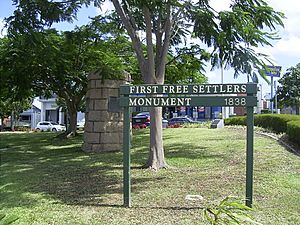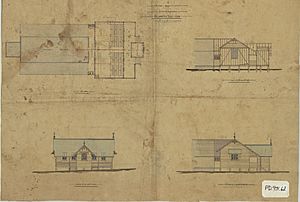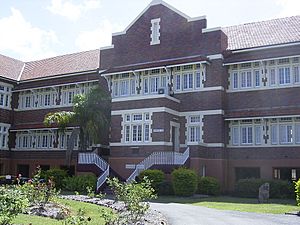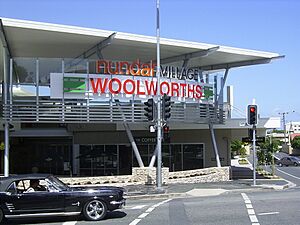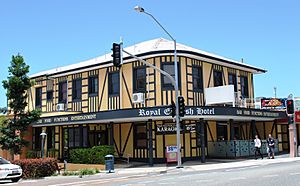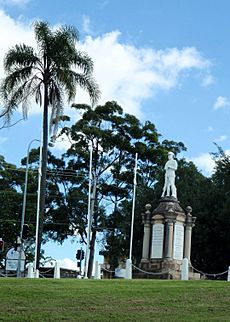Nundah, Queensland facts for kids
Quick facts for kids NundahBrisbane, Queensland |
|||||||||||||||
|---|---|---|---|---|---|---|---|---|---|---|---|---|---|---|---|
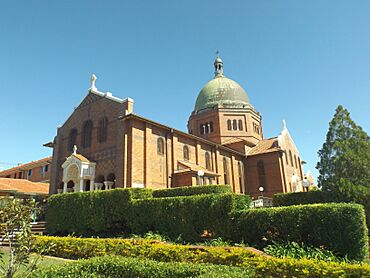
The Corpus Christi Church at Nundah
|
|||||||||||||||
| Population | 13,098 (2021 census) | ||||||||||||||
| • Density | 3,360/km2 (8,700/sq mi) | ||||||||||||||
| Postcode(s) | 4012 | ||||||||||||||
| Elevation | 10 m (33 ft) | ||||||||||||||
| Area | 3.9 km2 (1.5 sq mi) | ||||||||||||||
| Time zone | AEST (UTC+10:00) | ||||||||||||||
| Location | 8.9 km (6 mi) NNE of Brisbane CBD | ||||||||||||||
| LGA(s) | City of Brisbane (Hamilton Ward and Northgate Ward) |
||||||||||||||
| State electorate(s) | Nudgee | ||||||||||||||
| Federal Division(s) | Lilley | ||||||||||||||
|
|||||||||||||||
Nundah (once called German Station) is a suburb in Brisbane, Queensland, Australia. It's close to the city center. Part of Nundah is also known as Toombul. In 2021, about 13,098 people lived in Nundah.
Before Europeans arrived, Aboriginal people from the Turrbul tribe lived here. Nundah is mostly a place where people live. It sits along Sandgate Road, a main road in northern Brisbane. Europeans first settled here in the mid-1800s. But it stayed mostly a farming area until a railway connected it to Brisbane in the 1880s. Nundah used to be known as a working-class area. Now, it has a mix of old worker's homes and new apartment buildings. It is also near the Toombul Shopping Centre.
Contents
Exploring Nundah's Location
Nundah is a suburb with homes, some light factories, and shops along Sandgate Road. It is next to Clayfield, Northgate, and Wavell Heights. A big ridge runs through the suburb from northwest to southeast. The "Nundah Village" shops and Nundah State School are on this ridge. The George Bridges Tunnel cuts through the ridge along Sandgate Road.
Train Stations and Waterways
The North Coast railway line goes through Nundah. It has two train stations:
- Toombul railway station is in the south of the suburb.
- Nundah railway station is in the north.
The suburb also includes the area called Toombul. Many places in Nundah are named after Toombul, like Toombul Shopping Centre and Toombul railway station.
Schulz Canal flows through Nundah. It even goes through the Toombul Shopping Centre car park. This car park can flood quickly during big storms. The end of the canal is a good spot for fishing.
Zion Hill is a place in Nundah. German missionaries named it after Zion in Jerusalem in 1838.
Nundah's History
Aboriginal Life in Nundah
The Turrbul tribe lived in the Nundah area. Their old trade path along the coast went through Nundah. There are also many important Aboriginal sites nearby. For example, Dinah Island was a place for traditional Aboriginal burials. There were also bora rings, which suggests many Aboriginal people lived here long ago.
European Settlers Arrive
The German Mission
The first European settlement was a mission built in 1838. German missionaries from the Moravian Church started it. They wanted to teach Christianity to the local Aboriginal people. They first called the area "Zion." Later, it became "German Station."
The mission closed in 1846 because it wasn't very successful. A monument now stands where the first settlement was. It was put up in 1938. You can still see the names of these German settlers in street names like Rode Road.
Growing the Village of German Station
George Bridges was an important person in German Station. He came from England in 1852. In 1855, he bought land for farming. As Sandgate became a popular holiday spot, many coaches used Sandgate Road. So, George Bridges opened a hotel in 1866. It was a popular stop between Brisbane and Sandgate.
George Bridges also made a shortcut across his land. This shortcut helped travelers avoid a hill. This new path became the main shopping street in Nundah Village today. George Bridges later sold his land as the village grew.
Nundah Becomes a Suburb
German Station State School opened in 1865. It was renamed Nundah State School in 1895.
In 1881, the government bought land to build a railway line. The railway opened in 1882. This led to many new homes being built in Brisbane's north. German Station became a place where working-class families could find affordable homes.
A train station called "German" opened in 1882. Six weeks later, it was renamed "Nundah." The name "Nundah" comes from an Aboriginal word, nanda. It means "chain of water holes." This likely refers to the water sources nearby. In 1888, the Post Office also changed its name to Nundah.
In 1883, Eton Preparatory School moved to Nundah. It was a boarding school for boys. It closed in 1893 due to money problems. Later, the Sisters of the Society of the Sacred Advent used the building as a home for orphan girls. This school eventually moved and became St Margaret's Anglican Girls' School.
The Shire of Toombul was based in Nundah from 1890. This local government area later became part of the City of Greater Brisbane in 1925. The old Toombul Shire Hall is now a community center.
In 1901, the Tufnell Home orphanage opened in Nundah. It was run by the Anglican Church for children in need. It closed in 1993.
In 1909, the first public housing home in Queensland was built in Nundah. Nundah became a busy center in the early 1900s. This was because it was on Sandgate Road and had a train station. Shops, pubs, and cinemas lined the streets.
St Joseph's Convent and School opened in 1916. It was run by the Sisters of St Joseph of the Sacred Heart.
The Shire of Toombul War Memorial was opened in 1921. It remembers those who served in World War I. It is in Nundah Memorial Park.
Nundah Memorial Baptist Church opened in 1923. It has windows that remember soldiers who died in World War I.
In 1938, the First Free Settlers Monument was unveiled. It marks the start of European settlement in Nundah.
Mount St Joseph's Boarding & Day School for girls opened in 1953. It was renamed Corpus Christi College in 1964. In 2009, it became Mary MacKillop College.
Northgate State School opened in 1959.
Toombul Shopping Centre opened in 1967. It was built on raised land because the area could flood. It was the biggest shopping center in north Brisbane for a while. It was damaged in the 2022 Brisbane flood and will not reopen.
Nundah's main shopping area became less popular after Toombul Shopping Centre opened. It also became harder to park due to more traffic on Sandgate Road.
Nundah's Modern Renewal
In 2001, the Nundah Bypass Tunnel was built. This tunnel takes traffic away from the main shopping area. It was renamed the "George Bridges Tunnel" in 2009. This was to honor George Bridges, who helped develop the area.
In 1999, the old 1923 Baptist Church was taken down for the tunnel. A new North-East Baptist Church was built nearby in 2005.
Since 2008, the Brisbane City Council has worked to improve Nundah. New cafes and shops have opened. This has created a nice village feel. Nundah is now popular with people looking for homes not too far from Brisbane city. Housing prices have gone up a lot in recent years.
People in Nundah
In 2016, Nundah had 12,141 people. Most people (63.1%) were born in Australia. Other common birthplaces included India (5.9%), New Zealand (4.5%), and England (3.2%). Most people (72.7%) spoke only English at home.
In 2021, Nundah's population grew to 13,098 people.
Important Heritage Sites
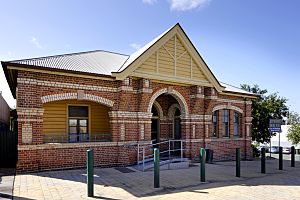
Nundah has several places listed as heritage sites. This means they are important historical buildings or areas. Some examples include:
- Nundah State School
- Toombul Shire Hall
- Nundah Cemetery, where many early settlers are buried.
- First Free Settlers Monument, which remembers the first European settlers.
- Nundah Air Raid Shelter, from World War II.
- Workers' Dwelling No.1, the first public housing home in Queensland.
- Nundah Fire Station
Schools in Nundah
Nundah has several schools for children:
- Nundah State School is a primary school (Prep–Year 6). It is for both boys and girls. In 2017, it had 714 students.
- Northgate State School is also a primary school (Prep–Year 6). It is in eastern Nundah. In 2018, it had 291 students.
- St Joseph's School is a Catholic primary school (Prep–Year 6). It is for boys and girls. In 2017, it had 190 students.
- Mary MacKillop College is a Catholic high school (Years 7–12) for girls. In 2017, it had 524 students. It used to be called Corpus Christi College.
There isn't a government high school in Nundah itself. The closest ones are Aviation High in Hendra and Wavell State High School in Wavell Heights.
Help Employment & Training helps people with disabilities find jobs and offers training.
Things to Do in Nundah
Shopping and Food
Nundah has a traditional "shopping strip" with many shops. It is mainly along the part of Sandgate Road that the bypass tunnel goes under. You can find cafes, special shops, and medical places here.
Churches in the Area
Nundah has had churches since the very first mission. The Lutheran church has St Paul's church, a childcare center, and a retirement home. Other churches in Nundah include Catholic, Presbyterian, Baptist, Uniting, and Anglican churches. Jehovah's Witnesses also have a Kingdom Hall here.
Libraries and Archives
The Nundah Public Library opened in 1968. It was updated in 2016. It is run by the Brisbane City Council.
The Sir William Knox Archives & Resource Centre is behind the library.
Sports and Parks
- The Toombul District Cricket Club is a big cricket ground. Famous players like Bill Brown and Jeff Thomson have played here.
- Bishop Park is the home ground for the Norths Devils rugby league team.
- Oxenham Park is also home to the Toombul District Cricket Club.
- Nundah Criterium Bicycle Track is a place for bike riding.
- Ross Park has BMX and skateboard areas.
There are many parks in Nundah, including:
- Albert Bishop Park
- Boyd Park
- Nundah Memorial Park (which has the Nundah War Memorial)
- Oxenham Park
- Kalinga Park
Community Groups
- Nundah Combined St John Ambulance Division
- Nundah-Northgate Scout Group (Scouts Australia)
Getting Around Nundah
Nundah has good transport options. Both Nundah railway station and Toombul railway station are in the suburb. Trains run often, seven days a week. Many council buses also run through the area.
The Nundah Bypass is a 285-meter long road tunnel. It goes under the Nundah Village shopping area. It opened in 2001. It helps cars avoid the busy streets of the village, making traffic better for local people.
How Nundah is Governed
Nundah is part of the Lilley area for federal elections. Wayne Swan from the Australian Labor Party has held this seat since 1998.
For state elections, Nundah is split between the Clayfield and Nudgee areas.
Locally, Nundah is part of the Northgate Ward in the City of Brisbane. Adam Allan from the LNP holds this position.
Famous People from Nundah
- George Bridges (1820–1898): A pioneer farmer and developer. The tunnel is named after him.
- Thomas Bridges (1853–1939): George Bridges' son and a politician.
- Bob Bax: A famous coach for the Norths Devils rugby league team.
- Elizabeth Grace OAM (born 1940): Honored for her service to the Nundah community.
- Trevor Hohns: An Australian test cricketer.
- Bill Knox (1927–2001): A politician and Treasurer of Queensland.
- Ken 'Slasher' Mackay: An Australian test cricketer.



